Sustainable Tourism Development: Planning in Qatar
VerifiedAdded on 2024/04/26
|27
|3466
|263
Report
AI Summary
This report provides a comprehensive overview of sustainable tourism development in Qatar, emphasizing the importance of balancing economic growth with social and environmental considerations. It examines the benefits for various stakeholders, including the local community, government, tourism authorities, and business organizations. The report also discusses the advantages and disadvantages of public-private sector partnerships in tourism planning. It highlights the features of tourism development planning at international, national, and regional levels, stressing the significance of interactive planning approaches. Furthermore, it explores different methods for measuring tourist impact, such as the STEAM model, Cambridge economic impact model, and pro-poor tourism. The report also addresses factors hindering sustainable tourism development and outlines strategies to overcome these barriers, including background analysis, strategy development, implementation, and monitoring. Finally, it discusses methods for resolving conflicts of interest and the implications of balancing supply and demand in Qatar's tourism sector.

SUSTAINABLE TOURISM DEVELOPMENT
Paraphrase This Document
Need a fresh take? Get an instant paraphrase of this document with our AI Paraphraser

1
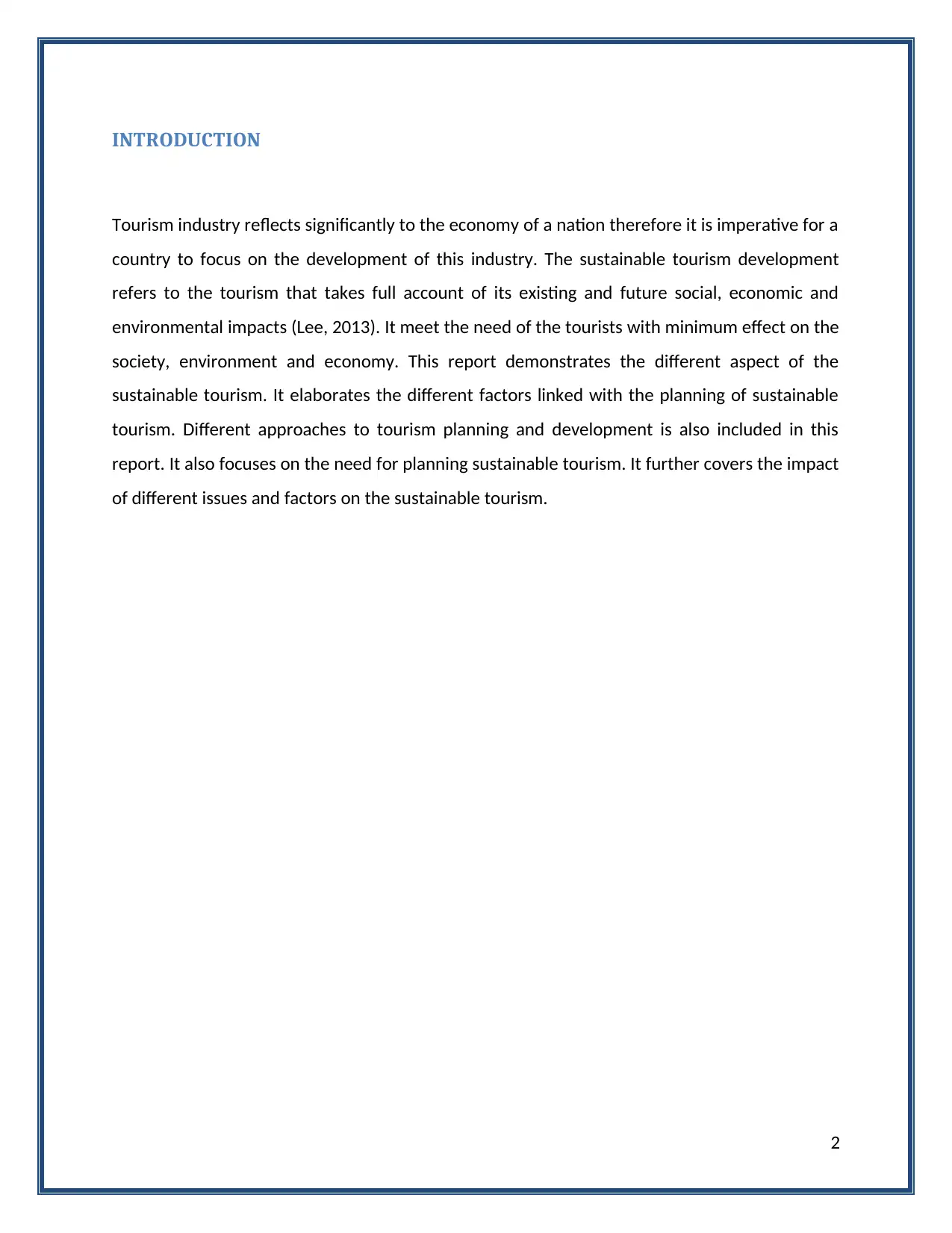
INTRODUCTION
Tourism industry reflects significantly to the economy of a nation therefore it is imperative for a
country to focus on the development of this industry. The sustainable tourism development
refers to the tourism that takes full account of its existing and future social, economic and
environmental impacts (Lee, 2013). It meet the need of the tourists with minimum effect on the
society, environment and economy. This report demonstrates the different aspect of the
sustainable tourism. It elaborates the different factors linked with the planning of sustainable
tourism. Different approaches to tourism planning and development is also included in this
report. It also focuses on the need for planning sustainable tourism. It further covers the impact
of different issues and factors on the sustainable tourism.
2
Tourism industry reflects significantly to the economy of a nation therefore it is imperative for a
country to focus on the development of this industry. The sustainable tourism development
refers to the tourism that takes full account of its existing and future social, economic and
environmental impacts (Lee, 2013). It meet the need of the tourists with minimum effect on the
society, environment and economy. This report demonstrates the different aspect of the
sustainable tourism. It elaborates the different factors linked with the planning of sustainable
tourism. Different approaches to tourism planning and development is also included in this
report. It also focuses on the need for planning sustainable tourism. It further covers the impact
of different issues and factors on the sustainable tourism.
2
⊘ This is a preview!⊘
Do you want full access?
Subscribe today to unlock all pages.

Trusted by 1+ million students worldwide
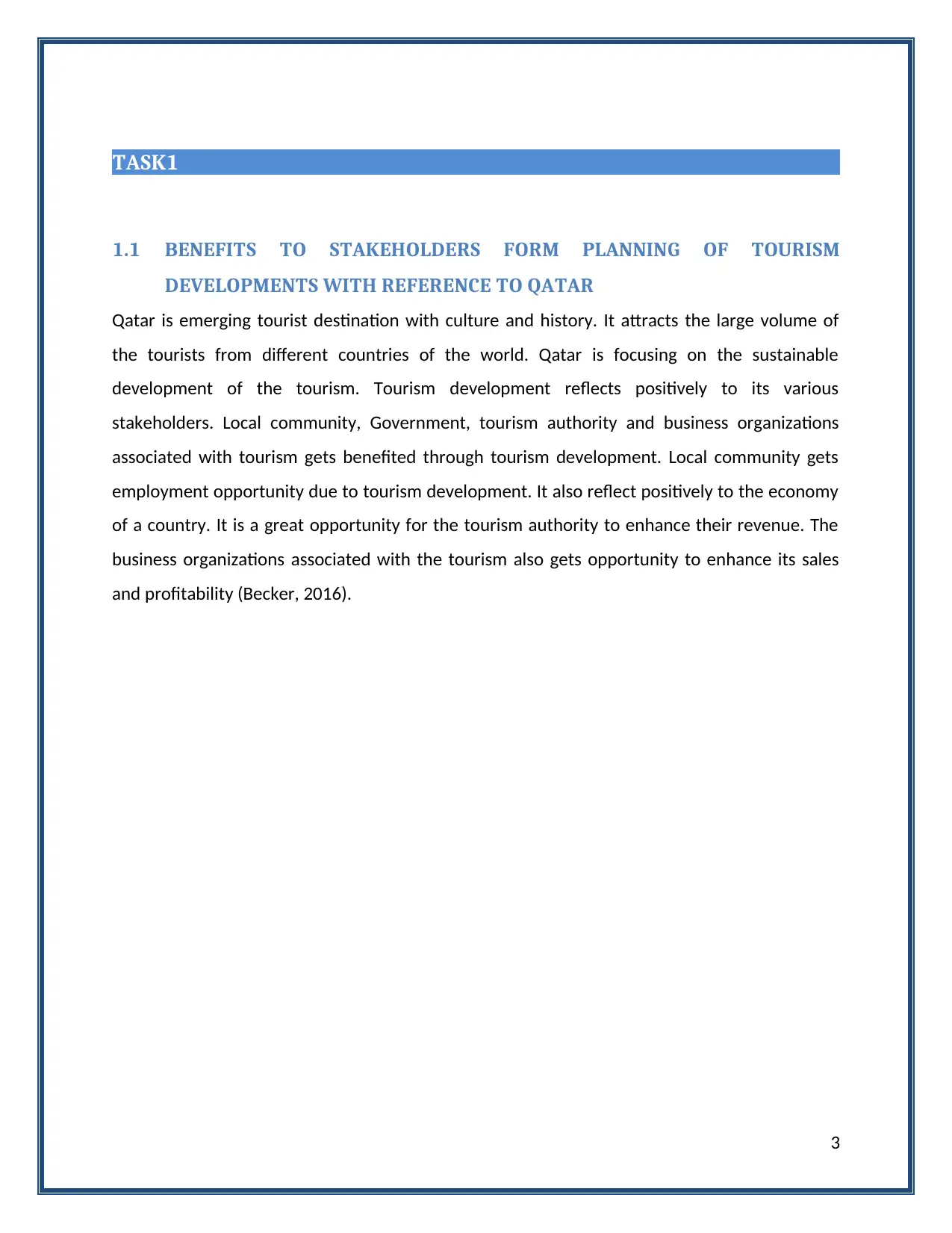
TASK1
1.1 BENEFITS TO STAKEHOLDERS FORM PLANNING OF TOURISM
DEVELOPMENTS WITH REFERENCE TO QATAR
Qatar is emerging tourist destination with culture and history. It attracts the large volume of
the tourists from different countries of the world. Qatar is focusing on the sustainable
development of the tourism. Tourism development reflects positively to its various
stakeholders. Local community, Government, tourism authority and business organizations
associated with tourism gets benefited through tourism development. Local community gets
employment opportunity due to tourism development. It also reflect positively to the economy
of a country. It is a great opportunity for the tourism authority to enhance their revenue. The
business organizations associated with the tourism also gets opportunity to enhance its sales
and profitability (Becker, 2016).
3
1.1 BENEFITS TO STAKEHOLDERS FORM PLANNING OF TOURISM
DEVELOPMENTS WITH REFERENCE TO QATAR
Qatar is emerging tourist destination with culture and history. It attracts the large volume of
the tourists from different countries of the world. Qatar is focusing on the sustainable
development of the tourism. Tourism development reflects positively to its various
stakeholders. Local community, Government, tourism authority and business organizations
associated with tourism gets benefited through tourism development. Local community gets
employment opportunity due to tourism development. It also reflect positively to the economy
of a country. It is a great opportunity for the tourism authority to enhance their revenue. The
business organizations associated with the tourism also gets opportunity to enhance its sales
and profitability (Becker, 2016).
3
Paraphrase This Document
Need a fresh take? Get an instant paraphrase of this document with our AI Paraphraser
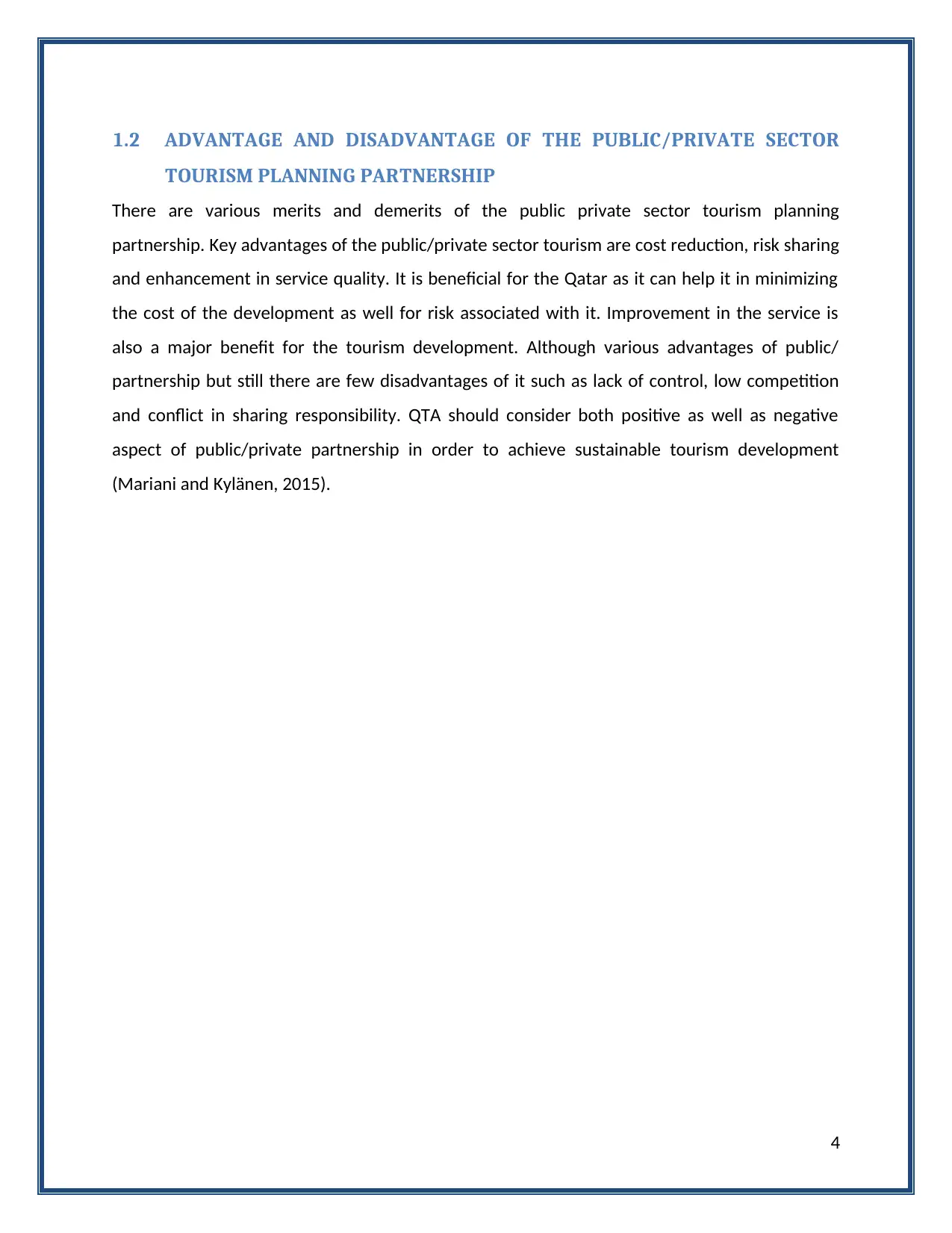
1.2 ADVANTAGE AND DISADVANTAGE OF THE PUBLIC/PRIVATE SECTOR
TOURISM PLANNING PARTNERSHIP
There are various merits and demerits of the public private sector tourism planning
partnership. Key advantages of the public/private sector tourism are cost reduction, risk sharing
and enhancement in service quality. It is beneficial for the Qatar as it can help it in minimizing
the cost of the development as well for risk associated with it. Improvement in the service is
also a major benefit for the tourism development. Although various advantages of public/
partnership but still there are few disadvantages of it such as lack of control, low competition
and conflict in sharing responsibility. QTA should consider both positive as well as negative
aspect of public/private partnership in order to achieve sustainable tourism development
(Mariani and Kylänen, 2015).
4
TOURISM PLANNING PARTNERSHIP
There are various merits and demerits of the public private sector tourism planning
partnership. Key advantages of the public/private sector tourism are cost reduction, risk sharing
and enhancement in service quality. It is beneficial for the Qatar as it can help it in minimizing
the cost of the development as well for risk associated with it. Improvement in the service is
also a major benefit for the tourism development. Although various advantages of public/
partnership but still there are few disadvantages of it such as lack of control, low competition
and conflict in sharing responsibility. QTA should consider both positive as well as negative
aspect of public/private partnership in order to achieve sustainable tourism development
(Mariani and Kylänen, 2015).
4

5
ADVANTAGES OF PUBLIC/ PRIVATE
SECTOR TOURISM PLANNING
Cost reduction
Risk sharing
Improvement in service quality
Low time consumption of project
DISADVANTAGE OF PUBLIC/ PRIVATE SECTOR
TOURISM PLANNING
Lack of control
Low competition
Conflict on sharing responsibility
PLANNING OF SUSTAINABLE TOURISM
KEY STAKEHOLDERS FOR PLANNING OF TOURISM
DEVELOPMENT
Stakeholders play an important role in the planning
of sustainable tourism development.
Key stakeholders for sustainable tourism are:
Local community
Government
Tourism authority or local authority
Business organizations associated with
tourism
Stakeholder
Local community
Government
Tourism authority
or regulatory body
Business
organizations
Benefit
Employment opportunities,
reorganization of crafts,
tradition, custom etc.
Economic growth,
promotion of country
Revenue generation,
recognition
Enhancement in sales and
profitability
ADVANTAGES OF PUBLIC/ PRIVATE
SECTOR TOURISM PLANNING
Cost reduction
Risk sharing
Improvement in service quality
Low time consumption of project
DISADVANTAGE OF PUBLIC/ PRIVATE SECTOR
TOURISM PLANNING
Lack of control
Low competition
Conflict on sharing responsibility
PLANNING OF SUSTAINABLE TOURISM
KEY STAKEHOLDERS FOR PLANNING OF TOURISM
DEVELOPMENT
Stakeholders play an important role in the planning
of sustainable tourism development.
Key stakeholders for sustainable tourism are:
Local community
Government
Tourism authority or local authority
Business organizations associated with
tourism
Stakeholder
Local community
Government
Tourism authority
or regulatory body
Business
organizations
Benefit
Employment opportunities,
reorganization of crafts,
tradition, custom etc.
Economic growth,
promotion of country
Revenue generation,
recognition
Enhancement in sales and
profitability
⊘ This is a preview!⊘
Do you want full access?
Subscribe today to unlock all pages.

Trusted by 1+ million students worldwide
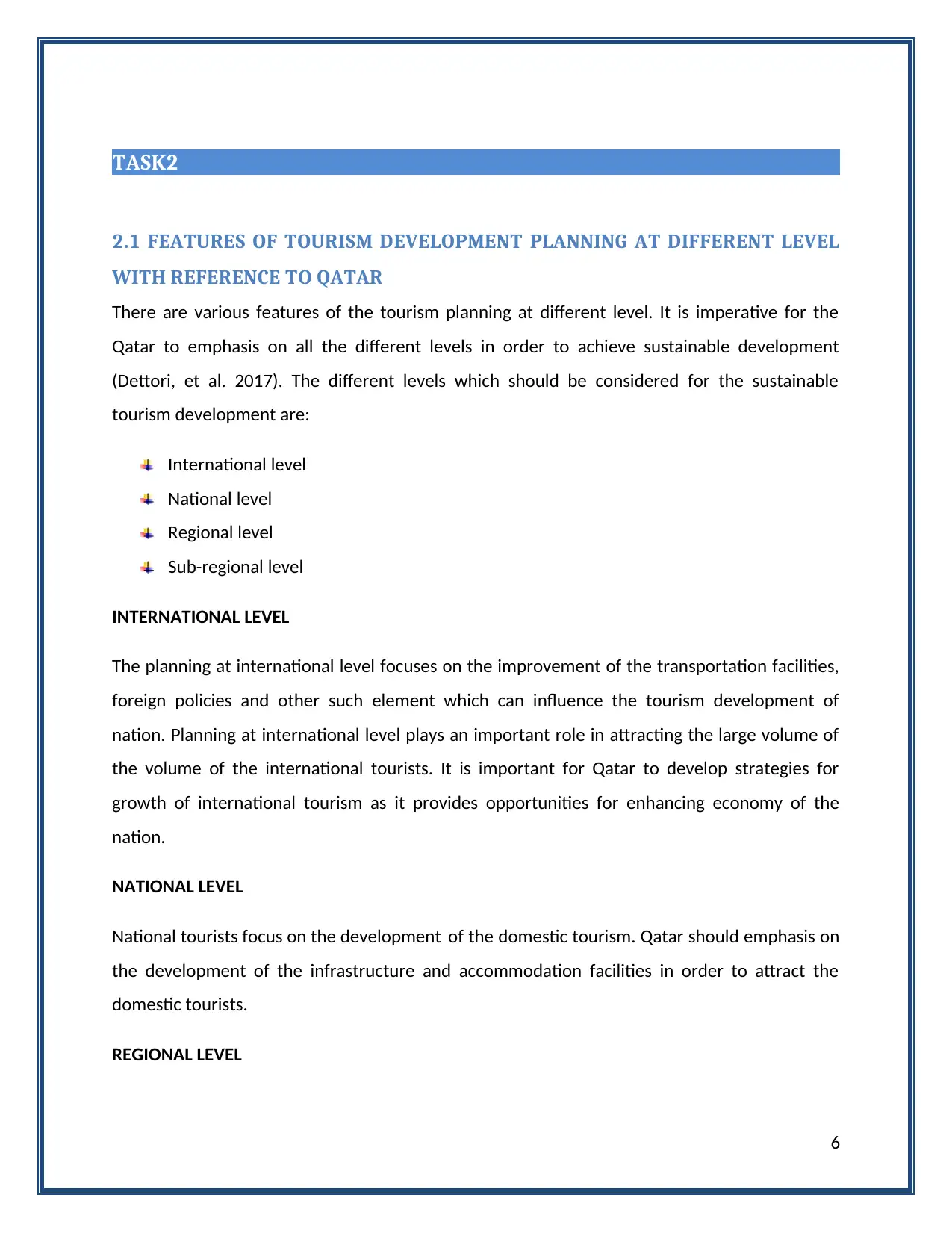
TASK2
2.1 FEATURES OF TOURISM DEVELOPMENT PLANNING AT DIFFERENT LEVEL
WITH REFERENCE TO QATAR
There are various features of the tourism planning at different level. It is imperative for the
Qatar to emphasis on all the different levels in order to achieve sustainable development
(Dettori, et al. 2017). The different levels which should be considered for the sustainable
tourism development are:
International level
National level
Regional level
Sub-regional level
INTERNATIONAL LEVEL
The planning at international level focuses on the improvement of the transportation facilities,
foreign policies and other such element which can influence the tourism development of
nation. Planning at international level plays an important role in attracting the large volume of
the volume of the international tourists. It is important for Qatar to develop strategies for
growth of international tourism as it provides opportunities for enhancing economy of the
nation.
NATIONAL LEVEL
National tourists focus on the development of the domestic tourism. Qatar should emphasis on
the development of the infrastructure and accommodation facilities in order to attract the
domestic tourists.
REGIONAL LEVEL
6
2.1 FEATURES OF TOURISM DEVELOPMENT PLANNING AT DIFFERENT LEVEL
WITH REFERENCE TO QATAR
There are various features of the tourism planning at different level. It is imperative for the
Qatar to emphasis on all the different levels in order to achieve sustainable development
(Dettori, et al. 2017). The different levels which should be considered for the sustainable
tourism development are:
International level
National level
Regional level
Sub-regional level
INTERNATIONAL LEVEL
The planning at international level focuses on the improvement of the transportation facilities,
foreign policies and other such element which can influence the tourism development of
nation. Planning at international level plays an important role in attracting the large volume of
the volume of the international tourists. It is important for Qatar to develop strategies for
growth of international tourism as it provides opportunities for enhancing economy of the
nation.
NATIONAL LEVEL
National tourists focus on the development of the domestic tourism. Qatar should emphasis on
the development of the infrastructure and accommodation facilities in order to attract the
domestic tourists.
REGIONAL LEVEL
6
Paraphrase This Document
Need a fresh take? Get an instant paraphrase of this document with our AI Paraphraser
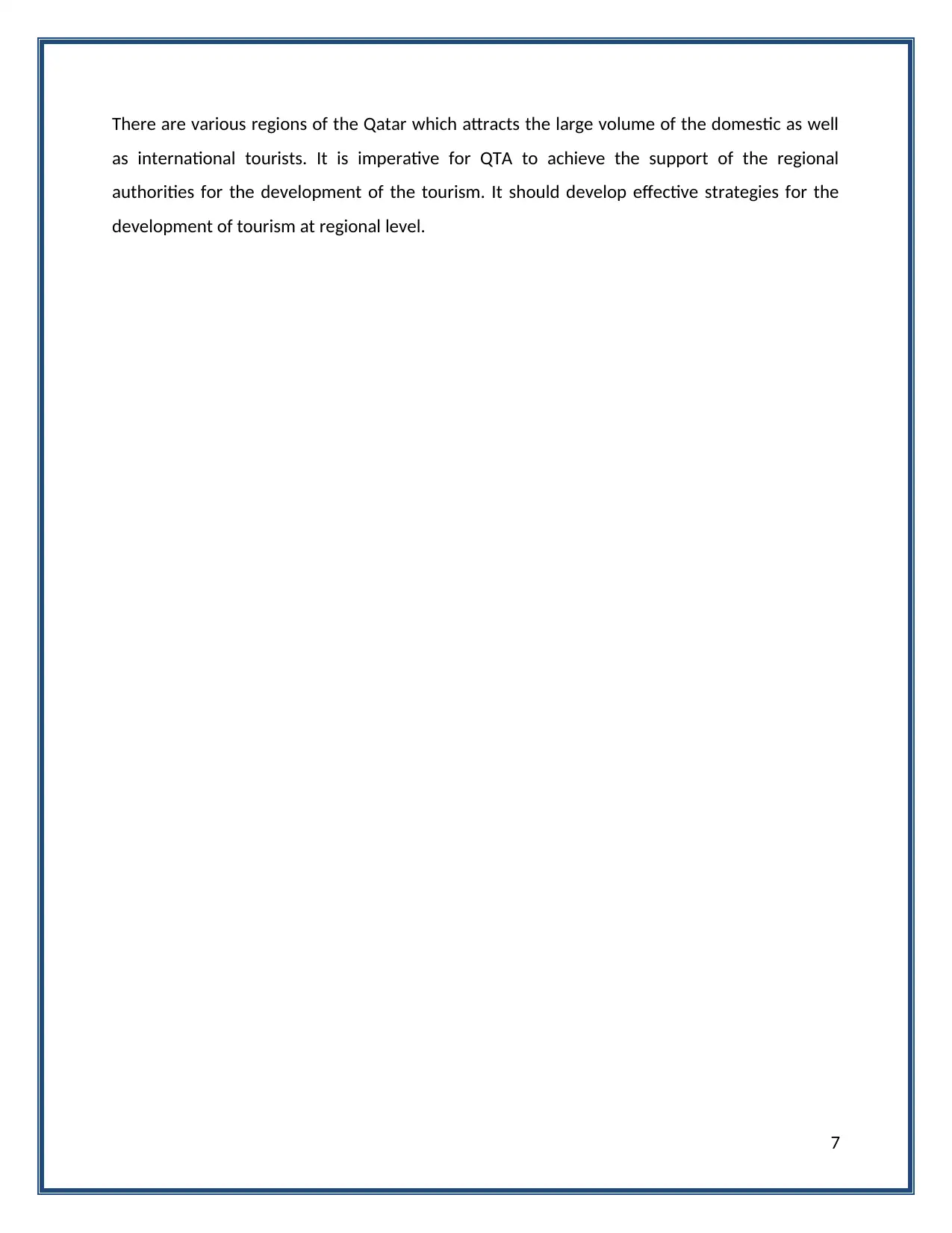
There are various regions of the Qatar which attracts the large volume of the domestic as well
as international tourists. It is imperative for QTA to achieve the support of the regional
authorities for the development of the tourism. It should develop effective strategies for the
development of tourism at regional level.
7
as international tourists. It is imperative for QTA to achieve the support of the regional
authorities for the development of the tourism. It should develop effective strategies for the
development of tourism at regional level.
7
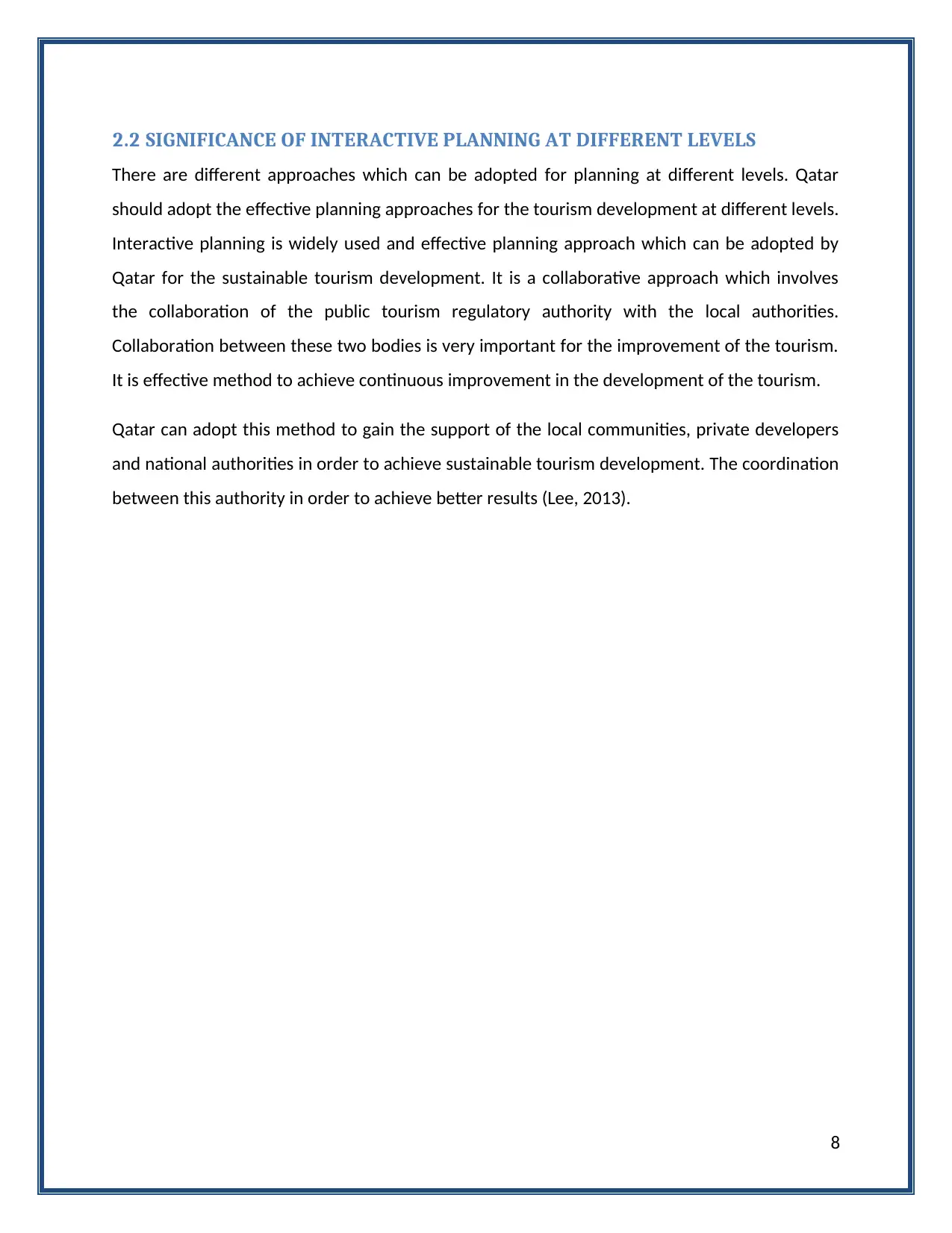
2.2 SIGNIFICANCE OF INTERACTIVE PLANNING AT DIFFERENT LEVELS
There are different approaches which can be adopted for planning at different levels. Qatar
should adopt the effective planning approaches for the tourism development at different levels.
Interactive planning is widely used and effective planning approach which can be adopted by
Qatar for the sustainable tourism development. It is a collaborative approach which involves
the collaboration of the public tourism regulatory authority with the local authorities.
Collaboration between these two bodies is very important for the improvement of the tourism.
It is effective method to achieve continuous improvement in the development of the tourism.
Qatar can adopt this method to gain the support of the local communities, private developers
and national authorities in order to achieve sustainable tourism development. The coordination
between this authority in order to achieve better results (Lee, 2013).
8
There are different approaches which can be adopted for planning at different levels. Qatar
should adopt the effective planning approaches for the tourism development at different levels.
Interactive planning is widely used and effective planning approach which can be adopted by
Qatar for the sustainable tourism development. It is a collaborative approach which involves
the collaboration of the public tourism regulatory authority with the local authorities.
Collaboration between these two bodies is very important for the improvement of the tourism.
It is effective method to achieve continuous improvement in the development of the tourism.
Qatar can adopt this method to gain the support of the local communities, private developers
and national authorities in order to achieve sustainable tourism development. The coordination
between this authority in order to achieve better results (Lee, 2013).
8
⊘ This is a preview!⊘
Do you want full access?
Subscribe today to unlock all pages.

Trusted by 1+ million students worldwide
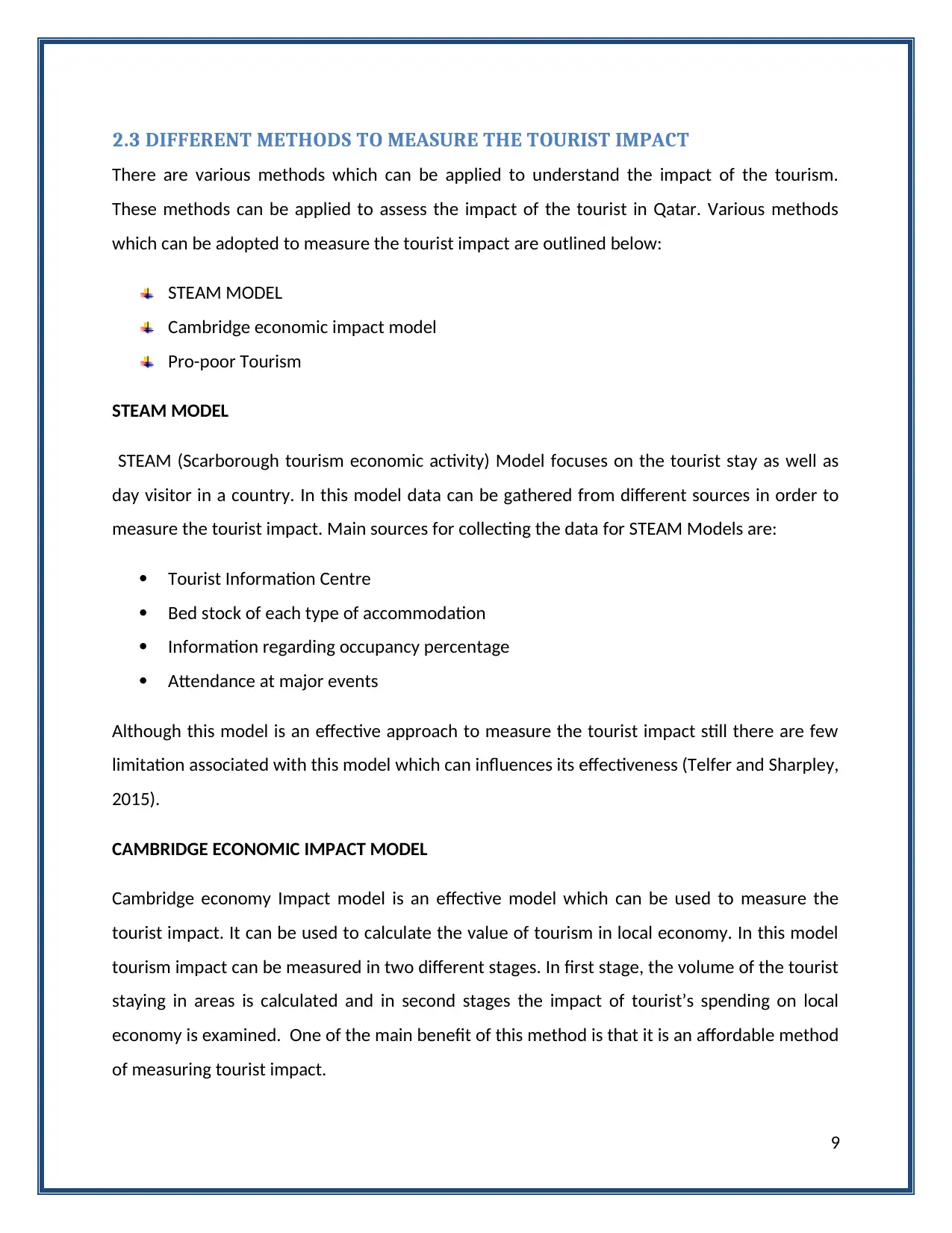
2.3 DIFFERENT METHODS TO MEASURE THE TOURIST IMPACT
There are various methods which can be applied to understand the impact of the tourism.
These methods can be applied to assess the impact of the tourist in Qatar. Various methods
which can be adopted to measure the tourist impact are outlined below:
STEAM MODEL
Cambridge economic impact model
Pro-poor Tourism
STEAM MODEL
STEAM (Scarborough tourism economic activity) Model focuses on the tourist stay as well as
day visitor in a country. In this model data can be gathered from different sources in order to
measure the tourist impact. Main sources for collecting the data for STEAM Models are:
Tourist Information Centre
Bed stock of each type of accommodation
Information regarding occupancy percentage
Attendance at major events
Although this model is an effective approach to measure the tourist impact still there are few
limitation associated with this model which can influences its effectiveness (Telfer and Sharpley,
2015).
CAMBRIDGE ECONOMIC IMPACT MODEL
Cambridge economy Impact model is an effective model which can be used to measure the
tourist impact. It can be used to calculate the value of tourism in local economy. In this model
tourism impact can be measured in two different stages. In first stage, the volume of the tourist
staying in areas is calculated and in second stages the impact of tourist’s spending on local
economy is examined. One of the main benefit of this method is that it is an affordable method
of measuring tourist impact.
9
There are various methods which can be applied to understand the impact of the tourism.
These methods can be applied to assess the impact of the tourist in Qatar. Various methods
which can be adopted to measure the tourist impact are outlined below:
STEAM MODEL
Cambridge economic impact model
Pro-poor Tourism
STEAM MODEL
STEAM (Scarborough tourism economic activity) Model focuses on the tourist stay as well as
day visitor in a country. In this model data can be gathered from different sources in order to
measure the tourist impact. Main sources for collecting the data for STEAM Models are:
Tourist Information Centre
Bed stock of each type of accommodation
Information regarding occupancy percentage
Attendance at major events
Although this model is an effective approach to measure the tourist impact still there are few
limitation associated with this model which can influences its effectiveness (Telfer and Sharpley,
2015).
CAMBRIDGE ECONOMIC IMPACT MODEL
Cambridge economy Impact model is an effective model which can be used to measure the
tourist impact. It can be used to calculate the value of tourism in local economy. In this model
tourism impact can be measured in two different stages. In first stage, the volume of the tourist
staying in areas is calculated and in second stages the impact of tourist’s spending on local
economy is examined. One of the main benefit of this method is that it is an affordable method
of measuring tourist impact.
9
Paraphrase This Document
Need a fresh take? Get an instant paraphrase of this document with our AI Paraphraser
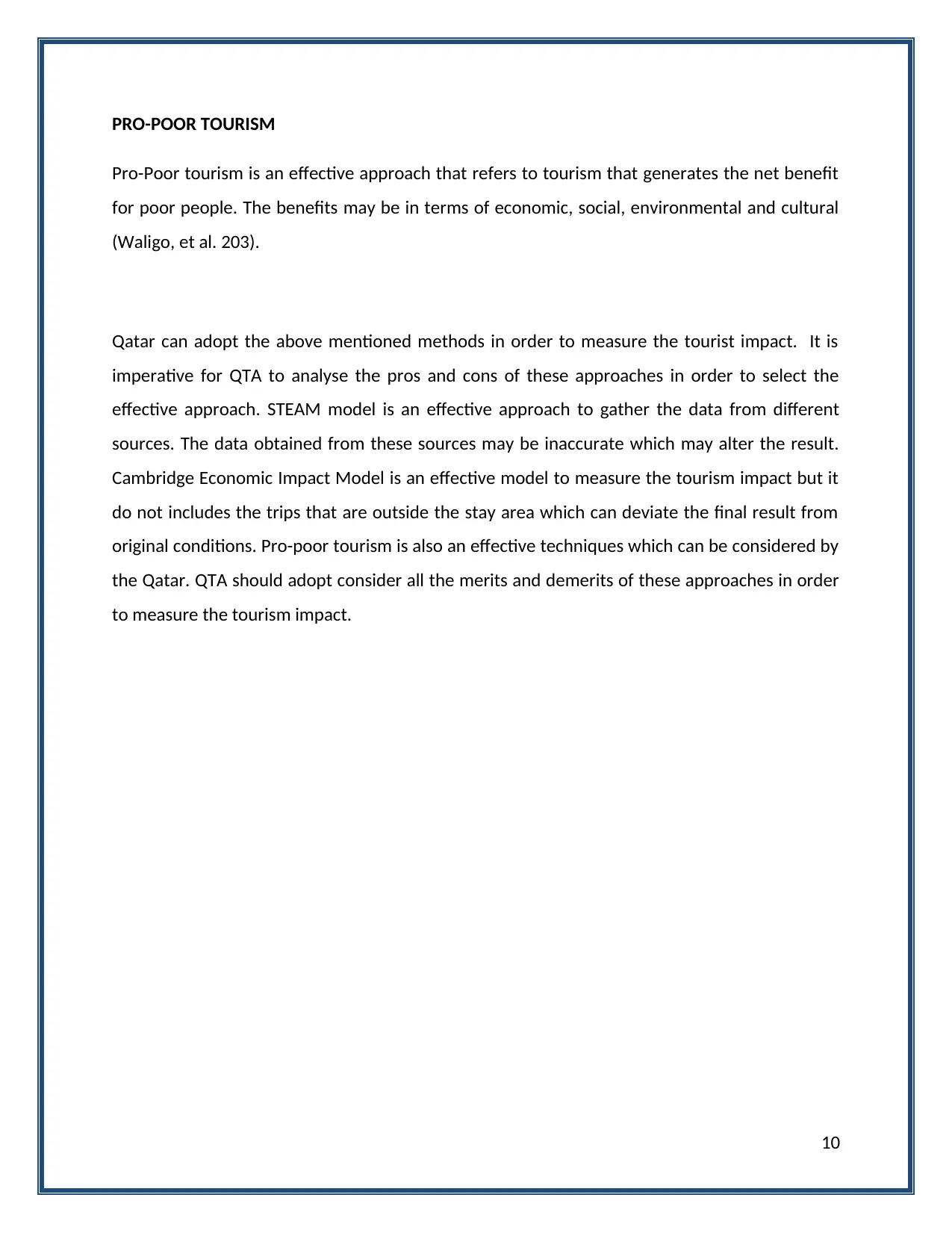
PRO-POOR TOURISM
Pro-Poor tourism is an effective approach that refers to tourism that generates the net benefit
for poor people. The benefits may be in terms of economic, social, environmental and cultural
(Waligo, et al. 203).
Qatar can adopt the above mentioned methods in order to measure the tourist impact. It is
imperative for QTA to analyse the pros and cons of these approaches in order to select the
effective approach. STEAM model is an effective approach to gather the data from different
sources. The data obtained from these sources may be inaccurate which may alter the result.
Cambridge Economic Impact Model is an effective model to measure the tourism impact but it
do not includes the trips that are outside the stay area which can deviate the final result from
original conditions. Pro-poor tourism is also an effective techniques which can be considered by
the Qatar. QTA should adopt consider all the merits and demerits of these approaches in order
to measure the tourism impact.
10
Pro-Poor tourism is an effective approach that refers to tourism that generates the net benefit
for poor people. The benefits may be in terms of economic, social, environmental and cultural
(Waligo, et al. 203).
Qatar can adopt the above mentioned methods in order to measure the tourist impact. It is
imperative for QTA to analyse the pros and cons of these approaches in order to select the
effective approach. STEAM model is an effective approach to gather the data from different
sources. The data obtained from these sources may be inaccurate which may alter the result.
Cambridge Economic Impact Model is an effective model to measure the tourism impact but it
do not includes the trips that are outside the stay area which can deviate the final result from
original conditions. Pro-poor tourism is also an effective techniques which can be considered by
the Qatar. QTA should adopt consider all the merits and demerits of these approaches in order
to measure the tourism impact.
10
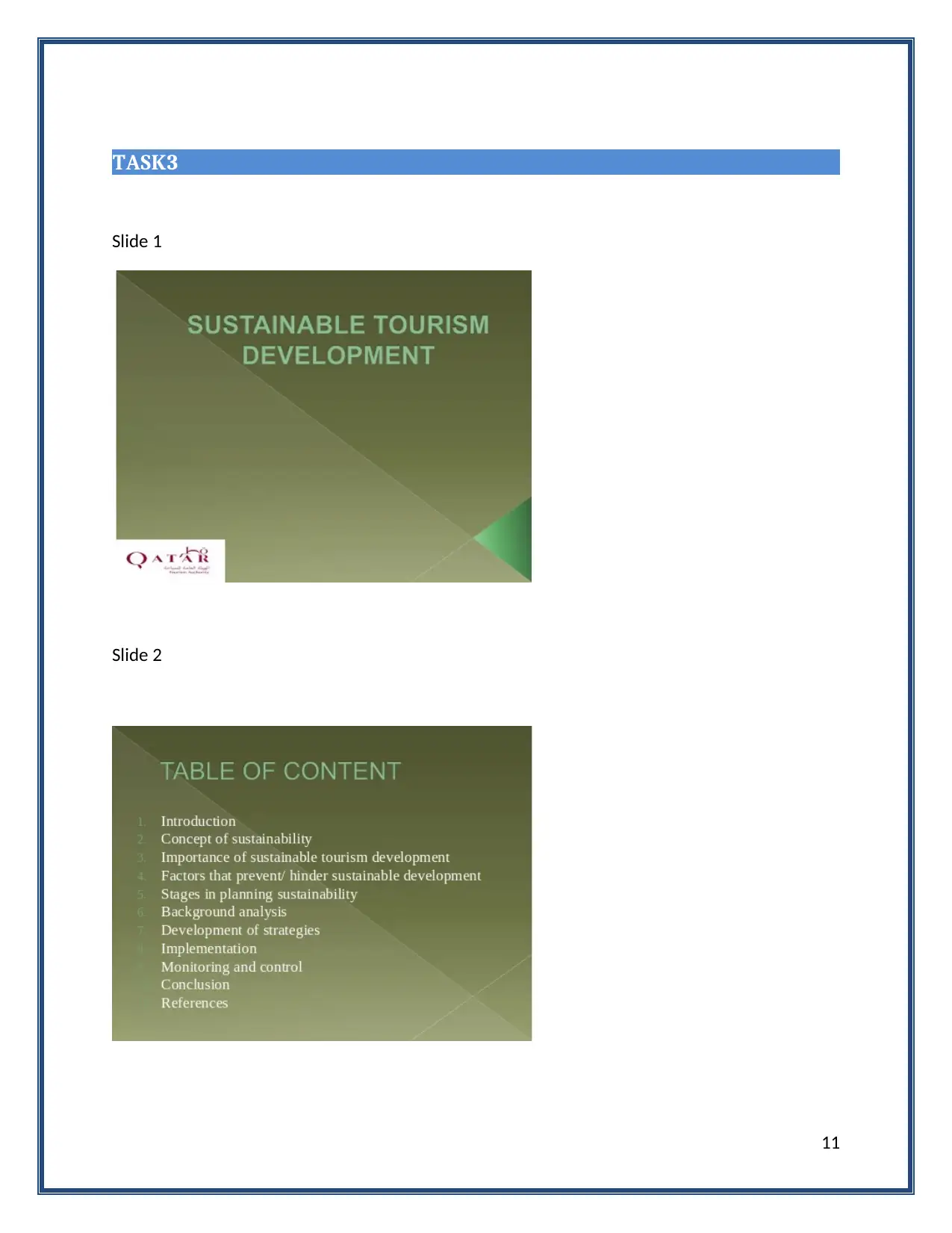
TASK3
Slide 1
Slide 2
11
Slide 1
Slide 2
11
⊘ This is a preview!⊘
Do you want full access?
Subscribe today to unlock all pages.

Trusted by 1+ million students worldwide
1 out of 27
Related Documents
Your All-in-One AI-Powered Toolkit for Academic Success.
+13062052269
info@desklib.com
Available 24*7 on WhatsApp / Email
![[object Object]](/_next/static/media/star-bottom.7253800d.svg)
Unlock your academic potential
Copyright © 2020–2025 A2Z Services. All Rights Reserved. Developed and managed by ZUCOL.




